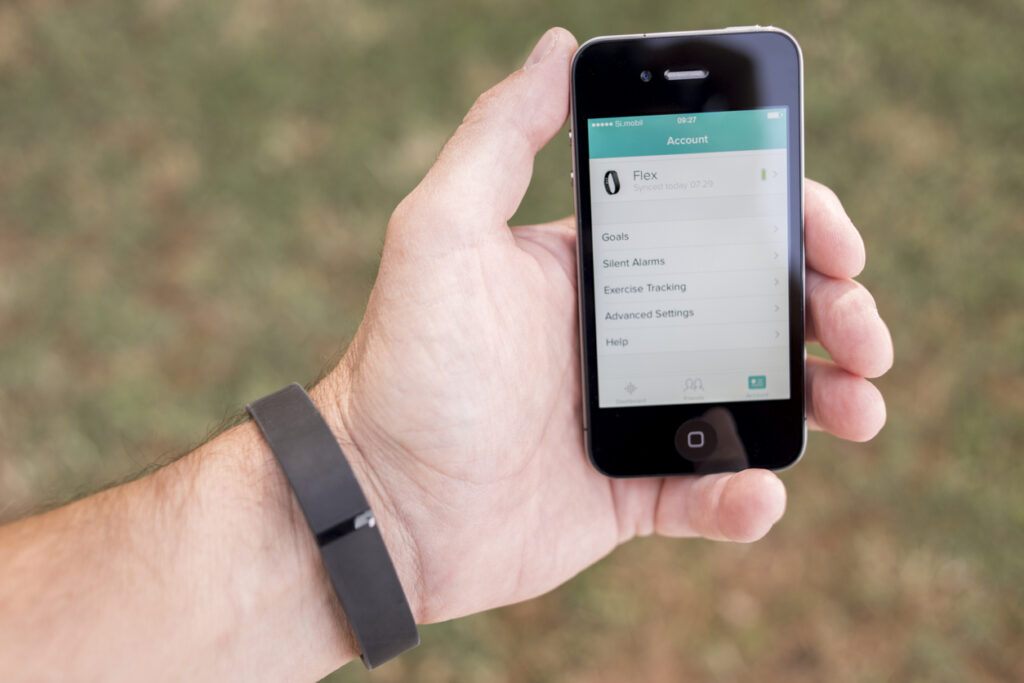In a world that is becoming increasingly data focused, everyone knows that knowledge is power, so should businesses start collecting and tracking biosensory data?
In the last ten years, advances in biosensory technology, which monitors and transmits information about life processes, have given us the tools to measure and monitor all kinds of data, including our own health. From tracking our weight and step count, to our blood pressure and heart rate, these technologies have the ability to provide us with an in-depth analysis of our health status in real-time.
If leaders want to perform regardless of external pressures, they must learn how to control internal pressures, i.e. their own mind and body.
It’s therefore not surprising that the sports industry has been quick to adopt biosensory technology as a tool for gaining deeper insights into how athletes’ performance can be improved. These technologies shouldn’t just be confined to the world of sport, however. When used effectively they can also provide leaders with a better understanding of how to leverage their own physical and mental performance, and that of their employees.
Helping leaders build resilience
Within the workplace, resilience is key to navigating periods of uncertainty, such as changes to departmental structures or indeed the business as a whole.
Unfortunately, resilience and stress go hand in hand. If leaders want to perform regardless of external pressures, they must learn how to control internal pressures, i.e. their own mind and body. This means recognising the balance between sufficient stress that motivates, and excessive stress that debilitates. The problem for most leaders is that they are unable to recognise their own tipping points because they have never been shown how to.
The data produced by biosensory technology allows leaders to see the physiological processes that are happening inside their own bodies and start to build an awareness of exactly what is out of balance.
For centuries our physiological response to stress has allowed us to survive, evolve and grow. The ‘fight or flight’ instinct, which we are all familiar with, is simply our brain processing information within the hypothalamus. This is an area of the brain that sends signals through the autonomic nervous system (responsible for regulating bodily functions) to the rest of the body, either to stimulate or to relax different functions. In order to evolve both as humans and as leaders, it is important to understand these responses and act accordingly.
This is where biosensory technology comes in. Within a business setting, biosensory technology allows individuals to measure their own stress levels. For instance, biofeedback sensors, which demonstrate the physical impact of stress on the body, can help employees monitor the reaction of their nervous system, not only to different environments but also to emotions, thoughts, and feelings.
What’s measured, how is it measured, and what for?
There are a wide variety of biofeedback tools available to businesses including:
- Heart rate variability (HRV): sensors on fingers, wrists or the torso that measure heart rate and heart rate variability and detect imbalances in the autonomic nervous system and anxiety.
- Galvanic skin response (skin conductance): measuring the amount of sweat on the surface of the skin to identify when sweating is triggered by emotional stimulation, rather than just the natural function of sweat.
- Skin temperature: using sensors that detect blood flow to the skin to signal distress and indicate a need for stress management tools.
- Brain waves (neurofeedback): electroencephalography (EEG) measures brain wave activity by connecting scalp sensors to an EEG device. The neurofeedback from the electrical activity provides an opportunity to retrain the brain and respond differently to certain situations and triggers.
- Muscle tension: using an electromyography (EMG) device to monitor electrical activity that results in muscle contractions, helps detect an individual’s level of emotional arousal when they do not display obvious actions or even inhibit certain behaviours.
Applying this to the everyday
The ability to control your physiology is key to optimising your brain’s activity, specifically in the frontal cortex or the ‘executive’ part of your brain. The data produced by biosensory technology allows leaders to see the physiological processes that are happening inside their own bodies and start to build an awareness of exactly what is out of balance.
Tracking their reactions to different situations will provide them with a greater understanding of their own triggers and allow them to take appropriate action to control their own response to stress.
As with any new initiative, the most effective and productive use of biosensory technology requires a holistic and integrated approach. Biosensory technology is notoriously difficult and live data alone may not be entirely reliable.
Using a combination of biosensory data and other behavioural assessments, such as psychometric tools as well as 360 feedback, will ensure a better rounded frame of reference for which leaders can base their development on.
Lasting impact
Biosensory technology has proved beneficial in personal development but must be coupled with targeted stress management training for maximum impact. If leaders can learn to control aspects of their own physiology, they can significantly improve their self-awareness and subsequently the quality of their performance.
Leaders wanting to make lasting change need to make a conscious effort to turn learned behaviours into habits. Being able to effectively respond to stress takes time, practice, perseverance and a holistic approach. Biosensory technology provides the roadmap, but training provides the solution.
Interested in this topic? Read Holistic learning: how to engage the body in learning.
In a world that is becoming increasingly data focused, everyone knows that knowledge is power, so should businesses start collecting and tracking biosensory data?
In the last ten years, advances in biosensory technology, which monitors and transmits information about life processes, have given us the tools to measure and monitor all kinds of data, including our own health. From tracking our weight and step count, to our blood pressure and heart rate, these technologies have the ability to provide us with an in-depth analysis of our health status in real-time.
If leaders want to perform regardless of external pressures, they must learn how to control internal pressures, i.e. their own mind and body.
It’s therefore not surprising that the sports industry has been quick to adopt biosensory technology as a tool for gaining deeper insights into how athletes’ performance can be improved. These technologies shouldn’t just be confined to the world of sport, however. When used effectively they can also provide leaders with a better understanding of how to leverage their own physical and mental performance, and that of their employees.
Helping leaders build resilience
Within the workplace, resilience is key to navigating periods of uncertainty, such as changes to departmental structures or indeed the business as a whole.
Unfortunately, resilience and stress go hand in hand. If leaders want to perform regardless of external pressures, they must learn how to control internal pressures, i.e. their own mind and body. This means recognising the balance between sufficient stress that motivates, and excessive stress that debilitates. The problem for most leaders is that they are unable to recognise their own tipping points because they have never been shown how to.
The data produced by biosensory technology allows leaders to see the physiological processes that are happening inside their own bodies and start to build an awareness of exactly what is out of balance.
For centuries our physiological response to stress has allowed us to survive, evolve and grow. The ‘fight or flight’ instinct, which we are all familiar with, is simply our brain processing information within the hypothalamus. This is an area of the brain that sends signals through the autonomic nervous system (responsible for regulating bodily functions) to the rest of the body, either to stimulate or to relax different functions. In order to evolve both as humans and as leaders, it is important to understand these responses and act accordingly.
This is where biosensory technology comes in. Within a business setting, biosensory technology allows individuals to measure their own stress levels. For instance, biofeedback sensors, which demonstrate the physical impact of stress on the body, can help employees monitor the reaction of their nervous system, not only to different environments but also to emotions, thoughts, and feelings.
What’s measured, how is it measured, and what for?
There are a wide variety of biofeedback tools available to businesses including:
- Heart rate variability (HRV): sensors on fingers, wrists or the torso that measure heart rate and heart rate variability and detect imbalances in the autonomic nervous system and anxiety.
- Galvanic skin response (skin conductance): measuring the amount of sweat on the surface of the skin to identify when sweating is triggered by emotional stimulation, rather than just the natural function of sweat.
- Skin temperature: using sensors that detect blood flow to the skin to signal distress and indicate a need for stress management tools.
- Brain waves (neurofeedback): electroencephalography (EEG) measures brain wave activity by connecting scalp sensors to an EEG device. The neurofeedback from the electrical activity provides an opportunity to retrain the brain and respond differently to certain situations and triggers.
- Muscle tension: using an electromyography (EMG) device to monitor electrical activity that results in muscle contractions, helps detect an individual’s level of emotional arousal when they do not display obvious actions or even inhibit certain behaviours.
Applying this to the everyday
The ability to control your physiology is key to optimising your brain’s activity, specifically in the frontal cortex or the ‘executive’ part of your brain. The data produced by biosensory technology allows leaders to see the physiological processes that are happening inside their own bodies and start to build an awareness of exactly what is out of balance.
Tracking their reactions to different situations will provide them with a greater understanding of their own triggers and allow them to take appropriate action to control their own response to stress.
As with any new initiative, the most effective and productive use of biosensory technology requires a holistic and integrated approach. Biosensory technology is notoriously difficult and live data alone may not be entirely reliable.
Using a combination of biosensory data and other behavioural assessments, such as psychometric tools as well as 360 feedback, will ensure a better rounded frame of reference for which leaders can base their development on.
Lasting impact
Biosensory technology has proved beneficial in personal development but must be coupled with targeted stress management training for maximum impact. If leaders can learn to control aspects of their own physiology, they can significantly improve their self-awareness and subsequently the quality of their performance.
Leaders wanting to make lasting change need to make a conscious effort to turn learned behaviours into habits. Being able to effectively respond to stress takes time, practice, perseverance and a holistic approach. Biosensory technology provides the roadmap, but training provides the solution.
Interested in this topic? Read Holistic learning: how to engage the body in learning.





